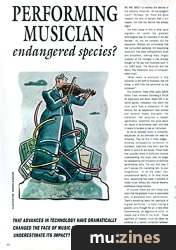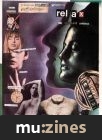Magazine Archive
Home -> Magazines -> Issues -> Articles in this issue -> View
Performing Musician: Endangered Species? | |
Article from Music Technology, March 1991 | |
Accusations of replacing "real" musicians have shifted from drum machine to sampler, but there may be other changes upon us. Steve Wright investigates the significance of the sequencer.
THAT ADVANCES IN TECHNOLOGY HAVE DRAMATICALLY CHANGED THE FACE OF MUSIC IS CERTAIN, BUT DO WE UNDERESTIMATE ITS IMPACT?

WE ARE ABOUT to witness the demise of the session musician. An extravagant claim? Perhaps, yet there are good reasons not only to believe that it will happen, but that the decline has already begun.
The main cause of this is what could arguably be called the greatest technological leap for musicians in the last decade - no, not the sampler, but the sequencer. Without the controversy that has surrounded sampling, the sequencing revolution has been comparatively quiet and bloodless, leaving many largely unaware of the changes it has already wrought on the way that musicians work. In his 1983 book, The Musician and the Micro, Ray Hammond said of computer-aided music:
"What really is profound in this revolution is the shift of emphasis that will follow: a shift from the performer to the composer!"
This prophecy, made three years before Simon Trask reviewed Steinberg's Pro24 for Electronics and Music Maker (MT in an earlier guise), nowadays may seem like little more than a statement of the obvious. But as sequencers have evolved and become widely available, the statement has acquired a deeper significance. Questions now arise about the nature of performance itself, and what it means to be able to play an instrument.
As far as recorded music is concerned, sequencers all but eliminate the need for rehearsal. They do this in three stages - allowing retrospective correction of mistakes, step-time note entry and the ability to record at any tempo. These mean that provided there is sufficient musical understanding, the music need no longer be hampered by any limitations of technical performance skills. The only limit now, if you'll excuse the marketing talk, is your imagination - or at the least, your compositional ability. In its most brutal form, sequencing has made it possible to create music without any manual dexterity whatsoever being involved.
Of course, there are still those who claim that the greatest music is associated with, or emanates from, performance. There's something about the spectacle of a great performer - a hand tracing a graceful curve through the air, a face tilted heavenwards, an aggressive strut, or maybe just a flick of the wrist - these signifiers of mastery could be taken as evidence of a sacred connection between the performer's movements and the resulting musical output. Contrast this with the image of a lone figure hunched over a computer, entering and adjusting notes one at a time, and it's difficult to see how this cramped, static body could produce music with dynamism, expressivity or soul.
The real-time performer, whether live or in the studio, has challenges which his computer-based counterpart does not; not least, to play a piece "perfectly" from beginning to end. Success depends on the level of mental and physical co-ordination acquired through practice. It's necessary to have rehearsed the piece to a stage whereby playing it becomes almost second nature - partly to avoid mistakes, but also to be free to "feel" the music as it is being played. The player has to be familiar enough with the music to be able to be consumed by it whilst producing it. To play "with feeling" involves not just the body playing the music, but also the music playing the body.
In live performance, audiences respond to theatrically exciting artists. Apart from any ritual aspects, the spectacle of exaggerated gestures is enjoyable, if only because the audience derive pleasure from identifying with the performer's involvement with the music.
Now, a concert pianist's hands can only control certain parameters: when the piano keys are pressed (the order in which the notes are played and the time distance between notes), how hard the keys are pressed, and how long they are held down for. Any piano performance, regardless of the complexity of the music or of the sounds, can be reduced to these three factors alone. The sequencing equivalents are, of course, note start-time, velocity and duration.
Non-keyboard instruments give the player control over more parameters, such as vibrato, glissando, and timbre. Here, MIDI controllers are the nearest sequencing equivalents, but there is still some way to go technologically before an equivalent level of control can be exercised by computer-based musicians, so for the purposes of argument let's stick to the piano, where parity already exists.
"REGARDLESS OF THE TYPE OF MUSIC WE CHOOSE TO MAKE, SOME FORM OF COMPOSITION IS AN ESSENTIAL INGREDIENT, BUT HUMAN PERFORMANCE IS STILL AN OPTION."
Without trying to suggest that music's most profound social, cultural, political or emotional meanings can be understood by reducing music to start times, velocities and durations, I'm simply pointing out that the computer musician has access to the same parameters as the pianist. (This is true at least since Yamaha announced the Diskclavier - a real piano with MIDI, and sequencer clock durations became shorter than the ear can register.)
If the pianist's movements are understood as the effects of the music playing the body - a necessary part of the real-time performance demand of playing "with feeling", (plus, in the live situation, the optional benefit of theatricality), then no reason remains why a piece of piano music created note by note with a sequencer and played back on a MIDI piano cannot have the same qualities as a piece that has been played directly on the piano. In other words, in a Studio situation at least, there is nothing sacred or necessary about the pianist's physical contact with the piano that guarantees a superior result, whatever the musical style.
Composers have rarely been able to play every instrument they have written for but, by knowing the capabilities of the instruments, they have been able to provide adequate instructions to performers. That is, the ability to perform has never been a precondition of becoming a composer. But the composer now has unprecedented freedom to test ideas and accept or reject them at any stage of the writing process. Sequencing is freeing the composer completely from the limits of human performance.
The fact that without being able to play a note, it is possible to create great music (that may, incidentally, be too difficult for anyone to play), is still hard for many people to accept. But it is precisely this fact which makes sequencing such an important and exciting development.
Are we ready for it? Have the limits of human performance, over the centuries, conditioned our listening tastes to such a degree that we are unmoved by the unplayable-sounding nature of music which transcends those limits? Just as we find it difficult to comprehend distances that are greater or smaller than our eyes are able to perceive, maybe it's hard to conceive and appreciate music that cannot be physically played. It may be significant that of all the sounds made accessible by sampling technology, the dominant tendency is still to use the sounds of playable instruments in a "natural" way. Yet since the boundaries of playability have never been clearly fixed, no great leap of the imagination is required to use a sequencer to artificially push them a little further this way or that. This too is a process already underway.
SEQUENCED MUSIC DOESN'T have to sound different if we don't want it to. Regardless of the type of music we choose to make, some form of composition is an essential ingredient, but performance is still an option. As composers, we have been empowered by the greater musical control and flexibility of sequencing, and as we develop our compositional and sequencing skills, advances in instrument and sequencer technology will take us closer to the time when instrumental players will be neither necessary nor desired in the recording studio.
What, then, of non-keyboard instruments? Well, there is no way (so far) that a computer-based musician controlling saxophone samples can do everything that a saxophonist controlling a saxophone can - even using the latest sampling technology and the best velocity-switched samples. There are simply too many ways of playing a sax. So will session players continue to be booked for the sake of instruments that cannot be easily emulated? Or will the inconvenience and expense of it all lead to the demise of the instruments and consequently the players? Apart from the aforementioned advantage to the composer of being able to test, then accept or reject musical ideas, time spent programming at home is very much cheaper than studio time plus session musician's rates. If it happens, it would not be the first time that instruments have died of inconvenience.
As long as there is a demand for live performance (coupled with revulsion at the sight of people pretending to play) there will continue to be a demand for skilled players. Besides, playing an instrument is therapeutic and an excellent aid to musical education and development. But there must already be parents who are weighing the cost of Junior's piano lessons against the cost of a MIDI keyboard, computer and software.
Where does this leave the human body? After all, the body insists on responding to music along with the mind - where would dance music be otherwise? Is there any form of performance dexterity which will always remain essential?
The most reassuring answer lies with the human voice. It is certainly the oldest of all instruments, and we can rely on it surviving all currently-foreseeable technological advances. That which is at the heart of folk and popular music and which makes a song a song, is also the only thing which ensures that the body will continue, not just to respond to music, but, with pleasure, to speak it.
More from these topics
Dance Music Sequencing Techniques |
A Picture Of Health - Musicians & Health |
 The Frontman Test |
Ultra Vox (Part 1) |
The Musical Micro |
Software Support - Hints, Tips & News From The World Of Music Software |
Software Support - Hints, Tips & News From The World Of Music Software |
Software Support - Hints, Tips & News From The World Of Music Software |
Sessiontime - Radio One - DJ Mix |
It’s My Song - And I'll Cry If I Want To |
 Bad Gigs |
Classical Style (Part 1) |
Browse by Topic:
Performing
Sequencing
Publisher: Music Technology - Music Maker Publications (UK), Future Publishing.
The current copyright owner/s of this content may differ from the originally published copyright notice.
More details on copyright ownership...
Feature by Steve Wright
Previous article in this issue:
Next article in this issue:
Help Support The Things You Love
mu:zines is the result of thousands of hours of effort, and will require many thousands more going forward to reach our goals of getting all this content online.
If you value this resource, you can support this project - it really helps!
Donations for April 2024
Issues donated this month: 0
New issues that have been donated or scanned for us this month.
Funds donated this month: £7.00
All donations and support are gratefully appreciated - thank you.
Magazines Needed - Can You Help?
Do you have any of these magazine issues?
If so, and you can donate, lend or scan them to help complete our archive, please get in touch via the Contribute page - thanks!














